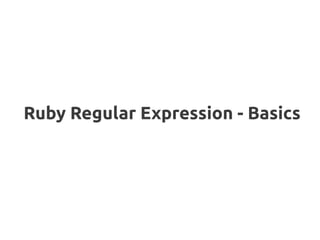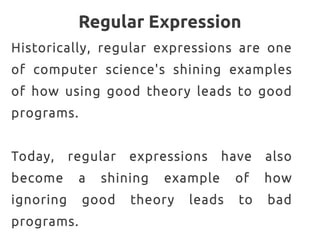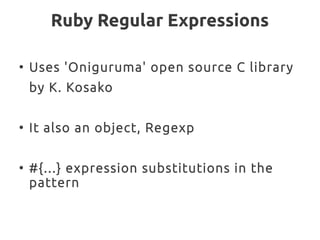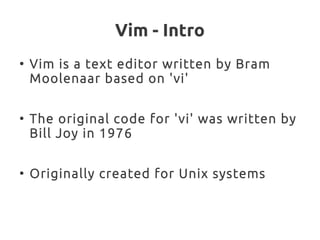Regular expressions in Ruby and Introduction to Vim
- 1. Ruby Regular Expression - Basics
- 2. Regular Expression Historically, regular expressions are one of computer science's shining examples of how using good theory leads to good programs. Today, regular expressions have also become a shining example of how ignoring good theory leads to bad programs.
- 3. What is regular expression ŌŚÅ Is a notation for describing a set of character strings ŌŚÅ sequence of characters within /, / ŌŚÅ single character within /, / is the simple regular expression Ex: /hello world/
- 4. What can be done with regular expression ? ŌŚÅ Test a string to see whether it matches a pattern ŌŚÅ Extract from a string the sections that match all or part of a pattern ŌŚÅ Change the string, replacing parts that match a pattern
- 5. Metacharcters ŌŚÅ Some characters have special meaning in regular expression ŌĆō ., |, (, ), [, ], {, }, +, , ^, $, * and ? ŌĆō ŌŚÅ They don't match themselves ŌŚÅ To match, escape it with '' Ex: '*' =~ /*/
- 6. Ruby Regular Expressions ŌŚÅ Uses 'Oniguruma' open source C library by K. Kosako ŌŚÅ It also an object, Regexp ŌŚÅ #{...} expression substitutions in the pattern
- 7. How to create pattern in ruby ? ŌŚÅ // Ex: /hello/ ŌŚÅ Regexp.new Ex: Regexp.new('hello') ŌŚÅ %r{...} Ex: %r{mm/dd}
- 8. Matching against String ŌĆ£When a particular string is in the set described by a regular expression, we often say that the regular expression matches the stringŌĆØ ŌŚÅ =~ ŌĆō Returns matched index / nil ŌŚÅ !~ ŌĆō Returns true / false ŌŚÅ match() ŌĆō Method of String & Regexp ŌĆō Returns MatchData object / nil
- 9. Regular expression options ŌŚÅ i ŌĆō case insensitive ŌŚÅ m ŌĆō multiline mode ŌŚÅ x ŌĆō Extended mode
- 10. Metacharacters ŌŚÅ Period ( . ) ŌĆō To match any character ŌĆō Should be escaped to match literal '.'
- 11. Metacharacters ŌŚÅ Anchors ŌĆō To restrict the pattern to match beginning or end of the line ŌĆō ^ - beginning of the line ŌĆō $ - end of the line ŌĆō A ŌĆō beginning of the string ŌĆō Z ŌĆō end of the string
- 12. Metacharacters ŌŚÅ Character Class ŌĆō Set of characters between [ and ] ŌĆō Can have ranges ŌĆō Can negate character sets ŌŚÅ Sequences d, D, w, W, s, S Ex: ŌŚÅ /[dr]ejected/ ŌŚÅ Match digits [0-9] ŌŚÅ Alphanumeric [A-Za-z0-9] ŌŚÅ Except digits [^0-9] ŌŚÅ Str.gsub(/['ŌĆØ]/,'')
- 13. Metacharacters ŌŚÅ Repetition ŌĆō r* Matches zero or more occurrences of r ŌĆō r+ Matches one or more occurrences of r ŌĆō r? Matches zero or one occurrence of r ŌĆō r{m,n} Matches at least m and at most n occurrences of r ŌĆō r{m,} Matches at least m occurrences of r ŌĆō r{,n} Matches at most n occurrences of r ŌĆō r{m } Matches exactly m occurrences of r
- 14. Metacharacters ŌŚÅ Alternation ŌĆō | Ex: /red|blue/ ŌŚÅ Grouping ŌĆō Everything within the group is treated as a single regular expression ŌĆō Backreferenced by numbers
- 15. Metacharacters ŌŚÅ Repetition ŌĆō r* Matches zero or more occurrences of r ŌĆō r+ Matches one or more occurrences of r ŌĆō r? Matches zero or one occurrence of r ŌĆō r{m,n} Matches at least m and at most n occurrences of r ŌĆō r{m,} Matches at least m occurrences of r ŌĆō r{,n} Matches at most n occurrences of r ŌĆō r{m } Matches exactly m occurrences of r
- 16. Vim Editor - Basics
- 17. Vim - Intro ŌŚÅ Vim is a text editor written by Bram Moolenaar based on 'vi' ŌŚÅ The original code for 'vi' was written by Bill Joy in 1976 ŌŚÅ Originally created for Unix systems
- 18. Vim ŌĆō Modes ŌŚÅ Normal Mode ŌĆō characters you type are commands ŌĆō Default mode ŌŚÅ Insert Mode ŌĆō the characters are inserted as text ŌĆō I, i, A, a, O, o switch to insert mode ŌĆō Escp key is to come back to normal mode
- 19. Vim ŌĆō Manipulation ŌŚÅ Delete ŌĆō d ŌĆō dw, dd, D, x, X ŌŚÅ Copy ŌĆō y ŌĆō yw, yy, Y ŌŚÅ Join ŌĆō J ŌŚÅ Paste ŌĆō P, p ŌŚÅ Replace ŌĆō r, R ŌŚÅ Undo & Redo ŌĆō u, Ctrl+r
- 20. Vim ŌĆō Navigation ŌŚÅ h, j, k , l ŌŚÅ w, b, e ŌŚÅ 0, ^, $ ŌĆō P, p ŌŚÅ G, gg ŌŚÅ % (matches {}()[ ]) ŌŚÅ Ctrl-b, Ctrl-f ŌŚÅ N G ( got to nth line)
- 21. Vim ŌĆō Search & Replace ŌŚÅ /pattern ŌŚÅ ?pattern ŌĆō N, n ŌŚÅ :range s/oldpattern/new/options ŌŚÅ F, f, t, T
- 22. Vim ŌĆō Misc ŌŚÅ Surrounding ŌŚÅ Swapcase ŌŚÅ Vim file +pageno ŌŚÅ Set nu, spell ŌŚÅ gf ŌŚÅ autocomplete
- 24. Thanks





![Metacharcters
ŌŚÅ
Some characters have special meaning
in regular expression
ŌĆō ., |, (, ), [, ], {, }, +, , ^, $, * and ?
ŌĆō
ŌŚÅ
They don't match themselves
ŌŚÅ
To match, escape it with ''
Ex: '*' =~ /*/](https://image.slidesharecdn.com/regularexpressions-130802024351-phpapp01/85/Regular-expressions-in-Ruby-and-Introduction-to-Vim-5-320.jpg)






![Metacharacters
ŌŚÅ
Character Class
ŌĆō Set of characters between [ and ]
ŌĆō Can have ranges
ŌĆō Can negate character sets
ŌŚÅ
Sequences
d, D, w, W, s, S
Ex:
ŌŚÅ
/[dr]ejected/
ŌŚÅ
Match digits [0-9]
ŌŚÅ
Alphanumeric [A-Za-z0-9]
ŌŚÅ
Except digits [^0-9]
ŌŚÅ
Str.gsub(/['ŌĆØ]/,'')](https://image.slidesharecdn.com/regularexpressions-130802024351-phpapp01/85/Regular-expressions-in-Ruby-and-Introduction-to-Vim-12-320.jpg)







![Vim ŌĆō Navigation
ŌŚÅ
h, j, k , l
ŌŚÅ
w, b, e
ŌŚÅ
0, ^, $
ŌĆō P, p
ŌŚÅ
G, gg
ŌŚÅ
% (matches {}()[ ])
ŌŚÅ
Ctrl-b, Ctrl-f
ŌŚÅ
N G ( got to nth line)](https://image.slidesharecdn.com/regularexpressions-130802024351-phpapp01/85/Regular-expressions-in-Ruby-and-Introduction-to-Vim-20-320.jpg)



